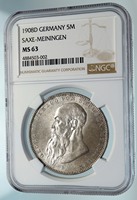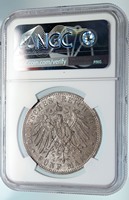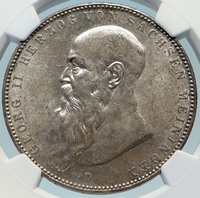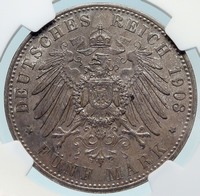Germany. German States. Duchy of Saxe-Meiningen
Georg II - Duke: 20 September 1866 - 25 June 1914
1908 D Silver 5 Mark 38mm (27.78 grams) 0.900 Silver (0.8037 oz. ASW) Munich mint
Reference: KM# 201 | Mintage: 60,000
Certification: NGC MS 63 4884503-002
GEORG II HERZOG VON SACHSEN-MEININGEN D; Bare head of George II left.
DEUTSCHES REICH 1908 * FÜNF MARK * around crowned German coat-of-arms eagle. You are bidding on the exact item pictured, provided with a Certificate of Authenticity and Lifetime Guarantee of Authenticity.
Saxe-Meiningen was one of the Saxon duchies held by the Ernestine line of the Wettin dynasty, located in the southwest of the present-day German state of Thuringia. Established in 1681, by partition of the Ernestine duchy of Saxe-Gotha among the seven sons of deceased Duke Ernst der Fromme (Ernest the Pious), the Saxe-Meiningen line of the House of Wettin lasted until the end of the German monarchies in 1918.
 Georg II, Duke of Saxe-Meiningen (2 April 1826 - 25 June 1914), was the penultimate Duke of Saxe-Meiningen, reigning from 1866 to 1914. For his support for his successful court theatre he was also known as the Theaterherzog (theatre duke). Georg II, Duke of Saxe-Meiningen (2 April 1826 - 25 June 1914), was the penultimate Duke of Saxe-Meiningen, reigning from 1866 to 1914. For his support for his successful court theatre he was also known as the Theaterherzog (theatre duke).
Georg was the only son of Bernhard II, Duke of Saxe-Meiningen and his wife Princess Marie Frederica of Hesse-Kassel.[1][self-published source?] His birth on 2 April 1826 was met with great relief as the succession to the duchy was in jeopardy due to a lack of male heirs in the family. Georg remained an only child for seventeen years, until the birth of his sister Princess Augusta in 1843. Georg spent his first few years under the supervision of his parents and grandmother the Dowager Duchess Luise Eleonore. It was the latter who instilled upon Georg the patriotic virtues of his heritage, as well as the sense of duty needed to rule a duchy. In 1862, his only sister married Prince Moritz of Saxe-Altenburg, a younger son of Georg, Duke of Saxe-Altenburg. They would be the parents of Ernst II, Duke of Saxe-Altenburg, the last reigning Duke of Saxe-Altenburg. Georg succeeded his father as Duke of Saxe-Meiningen on 20 September 1866, when Bernhard was forced to abdicate in favor of his son following the defeat of Austria in the Austro-Prussian War. In opposition to his father, Georg had sided with the Prussians during the war and was rewarded with a position of Lieutenant General of the Prussian army. The young duke was familiar enough with Prussian politics to regard their attitudes as impractical.[clarification needed][4] During the Franco-Prussian War, Georg led two regiments of soldiers from Meiningen and had the honor of capturing the first French flags at the Battle of Froeschweiler. Notably, he fought in nearly every battle during the war. Georg was a member of Wilhelm I's staff when he entered Paris and remained a friend of the Emperor until the latter's death in 1888. Meiningen EnsembleAfter the Franco-Prussian War, Georg devoted himself to theatre. He was one of the greatest intellectuals among the higher nobility during the German Empire.[citation needed] He is particularly known for developing the Meiningen Ensemble using his court theatre. Using his knowledge of art history and his drawing skills, he designed highly detailed, historically accurate scenery, costumes, and properties. In addition, he choreographed large crowd scenes that stunned audiences across Europe. He and his ensemble toured Europe extensively, and had a profound effect on theatre production across the continent. There is no doubt that Realism saw the development of the director as a separate entity, someone with an eye to oversee, someone responsible for the overall conception, interpretation, style and detail of the theatrical performance. The Meiningen Ensemble from its roots in the late 1830s under the directorships of Georg II and Ludwig Chronegk, proceeded to develop a theatre company bereft of theatre-managers and the star system. A system centered on realistic acting and staging and well-developed 'unified' productions. The Ensemble which began as a court theatre but started touring in 1874, used detailed research of people, locations, costumes and set, along with highly choreographed and individually detailed crowd scenes, to create productions which were esthetically unified and realistic in their presentations. In an article for the Deutsche Bühne, the Duke outlined his principles for directing a play, the most important were the creation of a Stage Picture (the pictorial effect created by the synthesis of the actors with the set and props), historical exactitude in the mise en scene, an acting style which used Precise Gestural and Vocal Imitation, the use of Period or Authentic Clothing and Costumes and the use of Group Orchestration by precise planning and direction of all group and crowd scenes The initial aim of the Meiningen Ensemble was to create, within the context of an ensemble, historical exactitude of the mise en scene. The Meiningen company sought to create the illusion of natural space within the confines of the proscenium arch. Duke Georg was concerned mainly with creating a naturalistic illusory atmosphere where the actor could establish or re-create authenticity in performance. Chronegk and the Duke prepared sketches and diagrams showing actors how to walk and move in period clothing to achieve a naturalistic feel to stage characterization. The Meiningen productions influenced playwrights like Henrik Ibsen, actors like Henry Irving and directors like Antoine and Stanislavsky. The conventions of realism for the Meiningen seemed to create the means by which a theatre artist creates the illusion of everyday life. They saw that art should copy science by depicting life 'as it is' without direct comment, interpretation and the structural edifice of the well made play. The Duke believed that a lifelike reality was achieved on stage through a careful study of the play and showing this in stage movement, composition and stage business. His major contribution to the stage was not just his use of realistic settings and costumes but in the way he tried to use and integrate performers as part of the mise en scene. The use of costume did not merely reflect historical accuracy but attempted to help actors perform in a style and mode which integrated with other elements. He demanded that all the actors were at most rehearsals and he carefully worked out the actions of even everyone in crowd scenes. Individual members of crowds and main actors alike were expected to provide specific research and character analysis related to the events depicted on stage. He was known for his great vision and memory and he often worked without a prompt book or script, working from his head and using a runner to ferry his ideas to his assistant Chronegk. Because his work toured extensively from 1874-1890, Meiningen's unified productions had a great impact on the theatre world. He is widely considered the theatre's first Modern director. Meiningen Court OrchestraThe Duke was also the patron of one of Europe's leading orchestras, the Meiningen Court Orchestra. The orchestra attained its distinction after the Duke hired the conductor Hans von Bülow in 1880. Bülow instituted stringent rehearsal methods and, with the Duke's agreement, hired eight musicians, raising its membership to 44. He offered the orchestra as a trial ensemble to Johannes Brahms, who was to try out his Second Piano Concerto and Third Symphony with the orchestra and premiered his Fourth Symphony there, conducting it himself. A dispute with Brahms over who was to conduct the premiere of his Fourth Symphony in Frankfurt led Bülow to resign (he was scheduled to premiere it there, but Brahms pre-empted him by conducting it with a local orchestra). Bülow was succeeded briefly by his 20-year-old assistant Richard Strauss, who resigned after a month, and then by Fritz Steinbach. Steinbach championed the music of Brahms, instituting Brahms Festivals in 1895 and 1897 in Meiningen with the composer present. A private concert by the Meiningen Court Orchestra and Steinbach for Brahms in 1891 led the composer to notice the artistry of the ensemble's first clarinetist, Richard Mühlfeld; Brahms promised to compose music for Mühlfeld, and did indeed compose his Clarinet Trio, Clarinet Quintet, and two Clarinet Sonatas. In 1897 the Duke undertook the construction of a Brahms monument in Meiningen's English gardens, sculpted by Adolf von Hildebrand. Later lifeIn his later life, Georg suffered from acute deafness and retired from active life. He had been fond of hunting and traveling, and was a collector of antiques and manuscripts. He died on 25 June 1914 at Bad Wildungen and was succeeded by his eldest son Bernhard. Georg is buried at Parkfriedhof Meiningen [de], next to his third wife.
 Germany, officially the Federal Republic of Germany, officially the Federal Republic of  Germany is a federal parliamentary republic in western-central Europe. It includes 16 constituent states and covers an area of 357,021 square kilometres (137,847 sq mi) with a largely temperate seasonal climate. Its capital and largest city is Berlin. With 81 million inhabitants, Germany is the most populous member state in the European Union. After the United States, it is the second most popular migration destination in the world. Germany is a federal parliamentary republic in western-central Europe. It includes 16 constituent states and covers an area of 357,021 square kilometres (137,847 sq mi) with a largely temperate seasonal climate. Its capital and largest city is Berlin. With 81 million inhabitants, Germany is the most populous member state in the European Union. After the United States, it is the second most popular migration destination in the world.
Various Germanic tribes have occupied northern Germany since classical antiquity. A region named Germania was documented before 100 CE. During the Migration Period the Germanic tribes expanded southward. Beginning in the 10th century, German territories formed a central part of the Holy Roman Empire. During the 16th century, northern German regions became the centre of the Protestant Reformation. The rise of Pan-Germanism inside the German Confederation resulted in the unification of most of the German states in 1871 into the Prussian-dominated German Empire. After World War I and the German Revolution of 1918-1919, the Empire was replaced by the parliamentary Weimar Republic. The establishment of the Third Reich in 1933 led to World War II and the Holocaust. After 1945, Germany split into two states, East Germany and West Germany. In 1990, the country was reunified.  In the 21st century, Germany is a great power and has the world's fourth-largest economy by nominal GDP, as well as the fifth-largest by PPP. As a global leader in several industrial and technological sectors, it is both the world's third-largest exporter and importer of goods. Germany is a developed country with a very high standard of living sustained by a skilled and productive society. It upholds a social security and universal health care system, environmental protection and a tuition free university education. In the 21st century, Germany is a great power and has the world's fourth-largest economy by nominal GDP, as well as the fifth-largest by PPP. As a global leader in several industrial and technological sectors, it is both the world's third-largest exporter and importer of goods. Germany is a developed country with a very high standard of living sustained by a skilled and productive society. It upholds a social security and universal health care system, environmental protection and a tuition free university education.
Germany was a founding member of the European Union in 1993. It is part of the Schengen Area, and became a co-founder of the Eurozone in 1999. Germany is a member of the United Nations, NATO, the G8, the G20, and the OECD. The national military expenditure is the 9th highest in the world. Known for its rich cultural history, Germany has been continuously the home of influential artists, philosophers, musicians, sportsmen, entrepreneurs, scientists and inventors.
|




 Georg II, Duke of Saxe-Meiningen (2 April 1826 - 25 June 1914), was the penultimate Duke of Saxe-Meiningen, reigning from 1866 to 1914. For his support for his successful court theatre he was also known as the Theaterherzog (theatre duke).
Georg II, Duke of Saxe-Meiningen (2 April 1826 - 25 June 1914), was the penultimate Duke of Saxe-Meiningen, reigning from 1866 to 1914. For his support for his successful court theatre he was also known as the Theaterherzog (theatre duke).  Germany, officially the Federal Republic of
Germany, officially the Federal Republic of  Germany is a federal parliamentary republic in western-central Europe. It includes 16 constituent states and covers an area of 357,021 square kilometres (137,847 sq mi) with a largely temperate seasonal climate. Its capital and largest city is Berlin. With 81 million inhabitants, Germany is the most populous member state in the European Union. After the United States, it is the second most popular migration destination in the world.
Germany is a federal parliamentary republic in western-central Europe. It includes 16 constituent states and covers an area of 357,021 square kilometres (137,847 sq mi) with a largely temperate seasonal climate. Its capital and largest city is Berlin. With 81 million inhabitants, Germany is the most populous member state in the European Union. After the United States, it is the second most popular migration destination in the world. In the 21st century, Germany is a great power and has the world's fourth-largest economy by nominal GDP, as well as the fifth-largest by PPP. As a global leader in several industrial and technological sectors, it is both the world's third-largest exporter and importer of goods. Germany is a developed country with a very high standard of living sustained by a skilled and productive society. It upholds a social security and universal health care system, environmental protection and a tuition free university education.
In the 21st century, Germany is a great power and has the world's fourth-largest economy by nominal GDP, as well as the fifth-largest by PPP. As a global leader in several industrial and technological sectors, it is both the world's third-largest exporter and importer of goods. Germany is a developed country with a very high standard of living sustained by a skilled and productive society. It upholds a social security and universal health care system, environmental protection and a tuition free university education.
